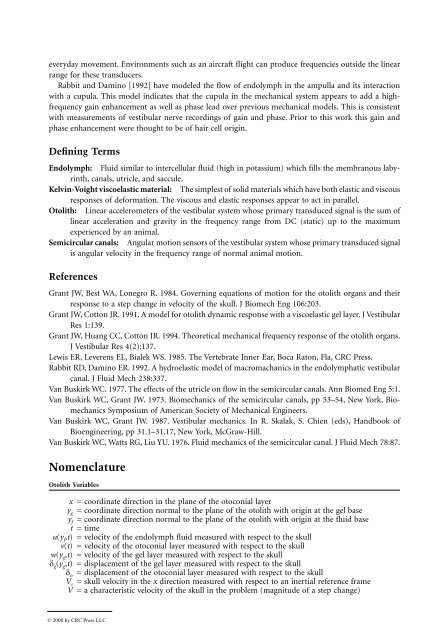chapter 36 - Vestibular Mechanics - KEMT FEI TUKE
chapter 36 - Vestibular Mechanics - KEMT FEI TUKE
chapter 36 - Vestibular Mechanics - KEMT FEI TUKE
Create successful ePaper yourself
Turn your PDF publications into a flip-book with our unique Google optimized e-Paper software.
everyday movement. Environments such as an aircraft flight can produce frequencies outside the linear<br />
range for these transducers.<br />
Rabbit and Damino [1992] have modeled the flow of endolymph in the ampulla and its interaction<br />
with a cupula. This model indicates that the cupula in the mechanical system appears to add a highfrequency<br />
gain enhancement as well as phase lead over previous mechanical models. This is consistent<br />
with measurements of vestibular nerve recordings of gain and phase. Prior to this work this gain and<br />
phase enhancement were thought to be of hair cell origin.<br />
Defining Terms<br />
Endolymph: Fluid similar to intercellular fluid (high in potassium) which fills the membranous labyrinth,<br />
canals, utricle, and saccule.<br />
Kelvin-Voight viscoelastic material: The simplest of solid materials which have both elastic and viscous<br />
responses of deformation. The viscous and elastic responses appear to act in parallel.<br />
Otolith: Linear accelerometers of the vestibular system whose primary transduced signal is the sum of<br />
linear acceleration and gravity in the frequency range from DC (static) up to the maximum<br />
experienced by an animal.<br />
Semicircular canals: Angular motion sensors of the vestibular system whose primary transduced signal<br />
is angular velocity in the frequency range of normal animal motion.<br />
References<br />
Grant JW, Best WA, Lonegro R. 1984. Governing equations of motion for the otolith organs and their<br />
response to a step change in velocity of the skull. J Biomech Eng 106:203.<br />
Grant JW, Cotton JR. 1991. A model for otolith dynamic response with a viscoelastic gel layer. J <strong>Vestibular</strong><br />
Res 1:139.<br />
Grant JW, Huang CC, Cotton JR. 1994. Theoretical mechanical frequency response of the otolith organs.<br />
J <strong>Vestibular</strong> Res 4(2):137.<br />
Lewis ER, Leverens EL, Bialek WS. 1985. The Vertebrate Inner Ear, Boca Raton, Fla, CRC Press.<br />
Rabbit RD, Damino ER. 1992. A hydroelastic model of macromachanics in the endolymphatic vestibular<br />
canal. J Fluid Mech 238:337.<br />
Van Buskirk WC. 1977. The effects of the utricle on flow in the semicircular canals. Ann Biomed Eng 5:1.<br />
Van Buskirk WC, Grant JW. 1973. Biomechanics of the semicircular canals, pp 53–54, New York, Biomechanics<br />
Symposium of American Society of Mechanical Engineers.<br />
Van Buskirk WC, Grant JW. 1987. <strong>Vestibular</strong> mechanics. In R. Skalak, S. Chien (eds), Handbook of<br />
Bioengineering, pp 31.1–31.17, New York, McGraw-Hill.<br />
Van Buskirk WC, Watts RG, Liu YU. 1976. Fluid mechanics of the semicircular canal. J Fluid Mech 78:87.<br />
Nomenclature<br />
Otolith Variables<br />
x = coordinate direction in the plane of the otoconial layer<br />
y g = coordinate direction normal to the plane of the otolith with origin at the gel base<br />
y f = coordinate direction normal to the plane of the otolith with origin at the fluid base<br />
t = time<br />
u(y f,t) = velocity of the endolymph fluid measured with respect to the skull<br />
v(t) = velocity of the otoconial layer measured with respect to the skull<br />
w(y g,t) = velocity of the gel layer measured with respect to the skull<br />
δ g(y g,t) = displacement of the gel layer measured with respect to the skull<br />
δ o = displacement of the otoconial layer measured with respect to the skull<br />
V s = skull velocity in the x direction measured with respect to an inertial reference frame<br />
V = a characteristic velocity of the skull in the problem (magnitude of a step change)<br />
© 2000 by CRC Press LLC








